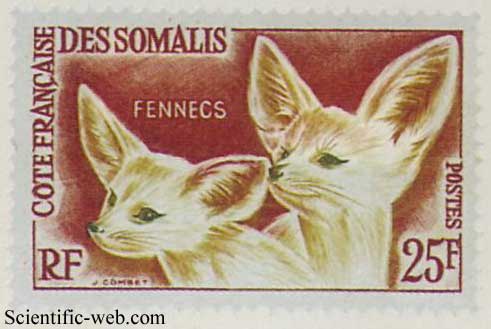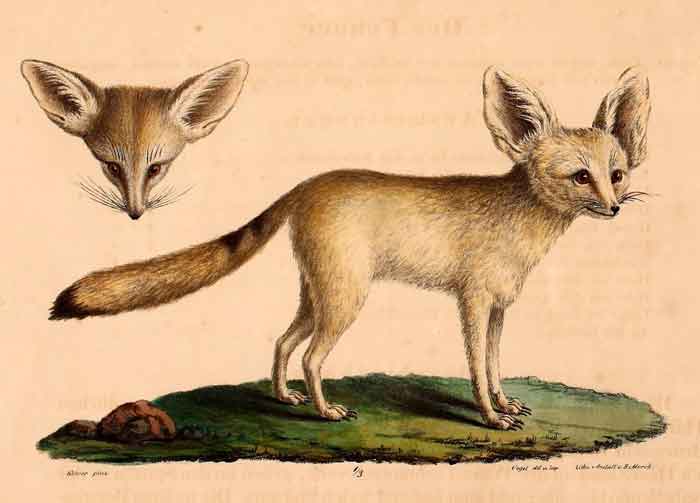
Superregnum: Eukaryota
Cladus: Unikonta
Cladus: Opisthokonta
Cladus: Holozoa
Regnum: Animalia
Subregnum: Eumetazoa
Cladus: Bilateria
Cladus: Nephrozoa
Superphylum: Deuterostomia
Phylum: Chordata
Subphylum: Vertebrata
Infraphylum: Gnathostomata
Megaclassis: Osteichthyes
Cladus: Sarcopterygii
Cladus: Rhipidistia
Cladus: Tetrapodomorpha
Cladus: Eotetrapodiformes
Cladus: Elpistostegalia
Superclassis: Tetrapoda
Cladus: Reptiliomorpha
Cladus: Amniota
Cladus: Synapsida
Cladus: Eupelycosauria
Cladus: Sphenacodontia
Cladus: Sphenacodontoidea
Cladus: Therapsida
Cladus: Theriodontia
Subordo: Cynodontia
Infraordo: Eucynodontia
Cladus: Probainognathia
Cladus: Prozostrodontia
Cladus: Mammaliaformes
Classis: Mammalia
Subclassis: Trechnotheria
Infraclassis: Zatheria
Supercohors: Theria
Cohors: Eutheria
Infraclassis: Placentalia
Cladus: Boreoeutheria
Superordo: Laurasiatheria
Cladus: Ferae
Ordo: Carnivora
Subordo: Caniformia
Familia: Canidae
Genus: Vulpes
Species: Vulpes zerda
Name
Vulpes zerda (Zimmermann, 1780)
Type locality: "Es bewohnt die Soara und andere Theile von Nordafrika hinter den Atlas, der Ritter Bruce behauptet, man fände es auch in tripolitanischen."
Synonyms
Canis cerdo Gmelin, 1788
Canis fennecus Lesson, 1827
Fennecus arabicus Desmarest, 1804
Fennecus zerda (Zimmermann, 1780)
Fennecus brucei Desmarest, 1820
Megalotis cerda Illiger, 1811
Viverra aurita F.A.A. Meyer, 1793
Vulpes denhamii Boitard, 1842
Vulpes saarensis Skjoldebrand, 1777
Vulpes zaarensis Gray, 1843
References
Zimmermann, E. A. W. 1780. Geographische Geschichte des Menschen, und der vierfu¨ ssigen Thiere. Weygandschen Buchhandlung, Leipzig, Germany 2:1–432 (247).
Serge Larivière 2002. Vulpes zerda, Mammalian Species, American Society of Mammalogists, No. 714, pp. 1–5, 3 figs.
Vulpes zerda in Mammal Species of the World.
Wilson, Don E. & Reeder, DeeAnn M. (Editors) 2005. Mammal Species of the World – A Taxonomic and Geographic Reference. Third edition. ISBN 0-8018-8221-4.
IUCN: Vulpes zerda (Zimmermann, 1780) (Least Concern)
Vulpes zerda (Zimmermann, 1780) – Taxon details on Integrated Taxonomic Information System (ITIS).
Vernacular names
العربية: فنك، ثعلب الصحراء
беларуская: Фенек
български: Фенек
català: Fennec
Deutsch: Wüstenfuchs, Fennek
English: Fennec
español: Fénec, zorro del desierto o zorro orejudo
eesti: Fennek, Kõrberebane, Fennekrebane
français: Fennec, Renard des sables du Sahara
hrvatski: Pustinjska lisica
magyar: Sivatagi róka
日本語: フェネック
한국어: 사막여우, 페넥여우
polski: Fenek
português: Raposa-Fennec
ไทย: หมาจิ้งจอกเฟนเนค, หมาจิ้งจอกทะเลทราย
Türkçe: Uzun kulaklı çöl tilkisi
українська: Фенек
中文: ÙǞ狐

The fennec fox (Vulpes zerda) is a small crepuscular fox native to the deserts of North Africa, ranging from Western Sahara to the Sinai Peninsula.[1] Its most distinctive feature is its unusually large ears, which serve to dissipate heat and listen for underground prey. The fennec is the smallest species of fox. Its coat, ears, and kidney functions have adapted to the desert environment with high temperatures and little water. It mainly eats insects, small mammals, and birds. The fennec has a life span of up to 14 years in captivity and about 10 years in the wild. Its main predators are the Verreaux's eagle-owl, jackals, and other large mammals. Fennec families dig out burrows in the sand for habitation and protection, which can be as large as 120 m2 (1,292 sq ft) and adjoin the burrows of other families. Precise population figures are not known but are estimated from the frequency of sightings; these indicate that the fennec is currently not threatened by extinction. Knowledge of social interactions is limited to information gathered from captive animals. The fennec's fur is prized by the indigenous peoples of North Africa, and in some parts of the world, it is considered an exotic pet.
Its name comes from the species' Arabic name: fanak (فَنَك).[2]
Description
Two fennec foxes
The fennec fox has sand-colored fur which reflects sunlight during the day and helps keep warm at night. Its nose is black. Its tapering tail has a black tip. Its long ears have longitudinal reddish stripes on the back and are so densely haired inside that the external auditory meatus is not visible.[3] The edges of the ears are whitish, but darker on the back. The ear to body ratio is the greatest in the canid family and likely helps in dissipating heat and locating vertebrates. It has dark streaks running from the inner eye to either side of the slender muzzle. Its large eyes are dark. The dental formula is 3.1.4.23.1.4.3 × 2 = 42 with small and narrow canines. The pads of its paws are covered with dense fur, which facilitates walking on hot, sandy soil.[4]
The fennec fox is the smallest canid. Females range in head-to-body size from 34.5 to 39.5 cm (13.6 to 15.6 in) with a 23–25 cm (9.1–9.8 in) long tail and 9–9.5 cm (3.5–3.7 in) long ears, and weigh 1–1.9 kg (2.2–4.2 lb). Males are slightly larger, ranging in head-to-body size from 39 to 39.5 cm (15.4 to 15.6 in) with a 23–25 cm (9.1–9.8 in) long tail and 10 cm (3.9 in) long ears, weighing at least 1.3 kg (2.9 lb).[4]
Distribution and habitat
The fennec fox is distributed throughout the Sahara, from Morocco and Mauritania to northern Sudan, through Egypt and its Sinai Peninsula.[1] It inhabits small sand dunes and vast treeless sand areas with sparse vegetation such as grasses, sedges and small shrubs.[4][5]
Behaviour and ecology
A fennec fox call
0:25
Problems playing this file? See media help.
Skull of a fennec fox
A fennec fox digs its den in sand, either in open areas or places sheltered by plants with stable sand dunes. In compacted soils, dens are up to 120 m2 (1,300 sq ft) large, with up to 15 different entrances. In some cases, different families interconnect their dens, or locate them close together. In soft, looser sand, dens tend to be simpler with only one entrance leading to a single chamber.[4]
Hunting and diet
The fennec fox is an omnivore, feeding on small rodents, lizards, geckos, skinks, small birds and their eggs, fruits and also some tubers. It relies on the moisture content of prey, but drinks water when available.[4] It hunts alone and digs in the sand for small vertebrates and insects. Some individuals were observed to bury prey for later consumption and searching for food in the vicinity of human settlements.[6]
In the Algerian Sahara, 114 scat samples were collected that contained more than 400 insects, plant fragments and date palm Phoenix dactylifera fruits, remains of birds, mammals, squamata and insects.[7]
Reproduction
Male fennec fox mounting a female
Captive fennec foxes reach sexual maturity at around nine months and mate between January and April.[8][9] They usually breed only once per year. The copulation tie lasts up to two hours and 45 minutes.[10] Gestation lasts between 50 and 52 days, sometimes also up to 63 days.[11][12] After mating, the male becomes very aggressive and protects the female, provides her with food during pregnancy and lactation.[13] Females give birth between March and June to a litter of one to four pups that open their eyes after 8 to 11 days.[12][9] Both female and male care for the pups. They communicate by barking, purring, yapping and squeaking. Pups remain in the family even after a new litter is born.[8] The pups are weaned at the age of 61 to 70 days.[14]
The oldest captive male fennec fox was 14 years old, and the oldest female 13 years.[4]
Diseases
Captive fennec foxes are susceptible to canine distemper virus, displaying fever, mucopurulent ocular discharge, diarrhea, severe emaciation, seizures, generalized ataxia, death, severe dehydration, brain congestion and gastric ulcers. Stress because of capture and long-distance transportation are thought to be the causes.[15]
Predators
African horned owl species such as the Pharaoh eagle-owl prey on fennec fox pups. Anecdotal reports exist about caracals, jackals, and striped hyenas also preying on the fennec fox. But according to nomads, the fennec fox is fast and changes directions so that even their Salukis are hardly able to capture it.[4]
Threats
In North Africa, the fennec fox is commonly trapped for exhibition or sale to tourists. Expansion of permanent human settlements in southern Morocco caused its disappearance in these areas and restricted it to marginal areas.[1]
Pets
The fennec fox is bred commercially as an exotic pet.[6] Commercial breeders remove the pups from their mother to hand-raise them, as tame foxes are more valuable. A breeders' registry has been set up in the United States to avoid any problems associated with inbreeding.[16] The fennec fox is classified as a "small wild/exotic canid" by the United States Department of Agriculture.[17]
Conservation
The fennec fox is listed in CITES Appendix II.[18] It is protected in Morocco (including Western Sahara), Algeria, Tunisia and Egypt, where it has been documented in several protected areas.[1]
Cultural depictions
The fennec fox is the national animal of Algeria.[19] It also serves as the nickname for the Algeria national football team: "Les Fennecs".[20]
"A greyscale sketch of a group of long eared foxes on a rocky outcrop in a desert. There is a crumbling brick building to the left and two of the foxes are on lookout."
A sketch of a pack of fennec foxes by Gustav Mützel, 1876
Citations
Wacher, T.; Bauman, K. & Cuzin, F. (2015). "Vulpes zerda". IUCN Red List of Threatened Species. 2015: e.T41588A46173447. doi:10.2305/IUCN.UK.2015-4.RLTS.T41588A46173447.en. Retrieved 19 November 2021.
"fennec". Merriam-Webster. Retrieved 30 January 2020.
Zimmermann, E.A.W. (1780). "Der Zerda". Geographische Geschichte des Menschen, und der allgemein verbreiteten vierfüßigen Thiere. Vol. II. Enthält ein vollständiges Verzeichniß aller bekannten Quadrupeden. Leipzig: Weygand. pp. 247–248.
Asa, C.S.; Valdespino, C. & Cuzin, F. (2004). "Fennec fox Vulpes zerda (Zimmermann, 1780)" (PDF). In Sillero-Zubiri, C.; Hoffman, M. & Mech, D. (eds.). Canids: Foxes, Wolves, Jackals and Dogs: Status Survey and Conservation Action Plan. Gland, Switzerland: IUCN/SSC Canid Specialist Group. pp. 205–209. ISBN 2-8317-0786-2.
Karssene, Y.; Chammem, M.; Li, F.; Eddine, A.; Hermann, A. & Nouira, S. (2019). "Spatial and temporal variability in the distribution, daily activity and diet of fennec fox (Vulpes zerda), red fox (Vulpes vulpes) and African golden wolf (Canis anthus) in southern Tunisia". Mammalian Biology. 95 (1): 41–50. doi:10.1016/j.mambio.2019.02.001. S2CID 91615641.
Asa, C.S. & Cuzin, F.A. (2013). "Vulpes zerda Fennec Fox". In Kingdon, J.; Happold, D.; Hoffmann, M.; Butynski, T.; Happold, M. & Kalina, J. (eds.). Mammals of Africa. Vol. V: Carnivores, Pangolins, Equids and Rhinoceroses. London, New Delhi, New York, Sydney: Bloomsbury. pp. 74–77. ISBN 978-1-4081-8994-8.
Brahmi, K.; Khechekhouche, E.A.; Mostefaoui, O.; Doumandji, S.; Baziz, Belkacem & Aulagnier, S. (2012). "First quantitative data on the diet of the fennec fox, Vulpes zerda (Canidae, Carnivora), in Algeria". Folia Zoologica. 61: 61–70. doi:10.25225/fozo.v61.i1.a10.2012. S2CID 86211731.
Gauthier-Pilters, H. (1967). "The Fennec". African Wildlife. 21: 117–125.
Saint Girons, M.C. (1962). "Notes sur les dates de reproduction en captivite du fennec, Fennecus zerda (Zimmerman, 1780)" (PDF). Zeitschrift für Säugertierkunde. 27: 181–184.
Valdespino, C.; Asa, C.S. & Bauman, J.E. (2002). "Estrous cycles, copulation and pregnancy in the fennec fox (Vulpes zerda)" (PDF). Journal of Mammalogy. 83 (1): 99–109. doi:10.1644/1545-1542(2002)083<0099:ECCAPI>2.0.CO;2. S2CID 51812228.
Petter, F. (1957). "La reproduction du fennec". Mammalia. 21: 307–309.
Gangloff, L. (1972). "Breeding fennec foxes Fennecus zerda at Strasbourg Zoo". International Zoo Yearbook. 12 (1): 115–116. doi:10.1111/j.1748-1090.1972.tb02289.x.
Sowards, R.K. (1981). "Observation on breeding and rearing the fennec fox (Fennecus zerda) in captivity". Animal Keepers' Forum. 8: 175–177.
Koenig, L. (1970). "Zur Fortpflanzung und Jungendentwicklung des Wüstenfuchses (Fennecus zerda Zimm. 1780)". Zeitschrift für Tierpsychologie. 27 (2): 205–246. doi:10.1111/j.1439-0310.1970.tb01873.x.
Woo, G.-H.; Jho, Y.-S.; Bak, E.-J. (2010). "Canine distemper virus infection in Fennec Fox (Vulpes zerda)". Journal of Veterinary Medical Science. 72 (8): 1075–1079. doi:10.1292/jvms.09-0510. PMID 20299771.
Roots, C. (2007). Domestication. Westport: Greenwood. pp. 113–114. ISBN 978-0-313-33987-5.
"Animal Inventory Sheet" (PDF). United States Department of Agriculture. Archived from the original (PDF) on 5 March 2010. Retrieved 21 December 2009.
"Appendices | CITES". cites.org. Retrieved 14 January 2022.
Hodges, K. "National Animals of African Countries". Archived from the original on 25 February 2014. Retrieved 19 February 2014.
Fifa (2009). "Paris salutes Les Fennecs". Fifa. Archived from the original on 1 June 2010.
General and cited references
Alderton, David (1998). Foxes, Wolves, and Wild Dogs of the World. London: Blandford. ISBN 081605715X.
Retrieved from "http://en.wikipedia.org/"
All text is available under the terms of the GNU Free Documentation License

